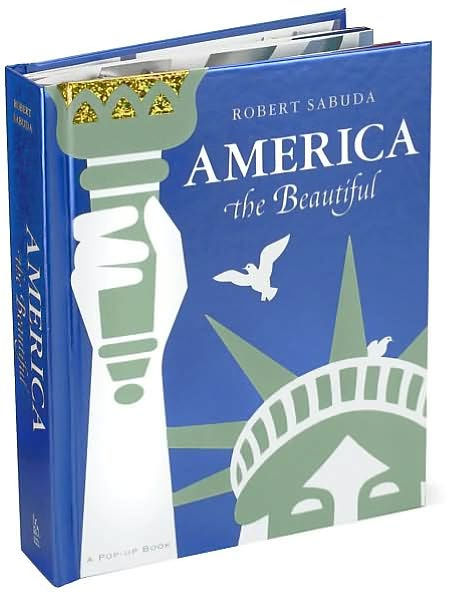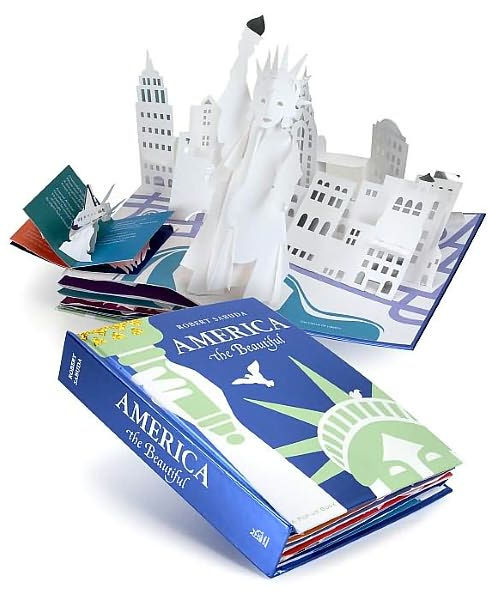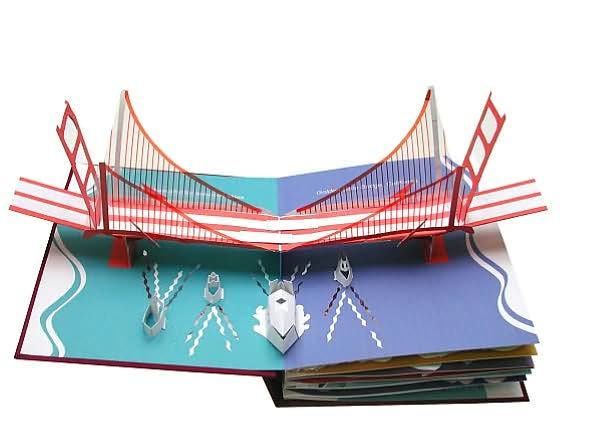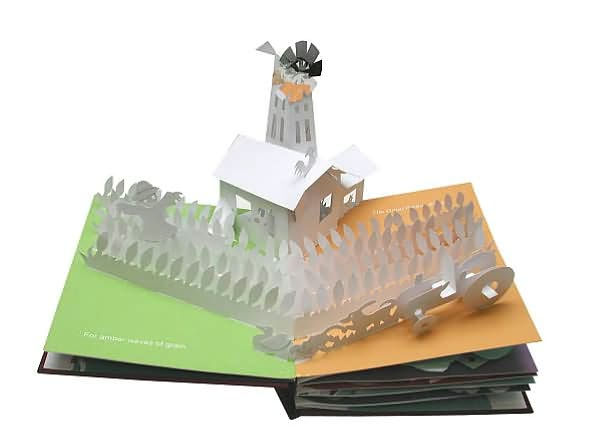Robert Sabuda again dazzles audiences with his brilliant paper engineering, this time honoring the USA and the legendary text by Katharine Lee Bates. From the Golden Gate Bridge to the Big Apple, Sabuda delivers dynamic spreads that combine his trademark white pop-ups against colored backgrounds. Notable spreads include the Great Plains, including a windmill that turns; a Mississippi River steamboat with spinning ribbons that symbolize the water in its paddle wheel; and a large Statue of Liberty set against the New York skyline. For anyone who needs an ample dose of patriotism or simply craves Sabuda's next book after Alice's Adventures in Wonderland, this stunning tribute is a treat that's not to be missed.
Prepare to be astonished by yet another 3-D marvel from famed paper engineer Sabuda. Every page turn of this intricately constructed pop-up book reveals an American landmark, each an interpretation of a phrase from Katherine Lee Bates's poem "America the Beautiful." Popping up on one spread are miniature versions of the Capitol building, Washington Monument, and Lincoln Memorial, where you can peek inside at a tiny Abraham Lincoln. (Ages 6 to 8)
Child magazine's Best Children's Book Awards 2004
Starched-white shapes of icons such as the Statue of Liberty and a Mississippi riverboat unfold in this patriotic pop-up. Paper engineer Sabuda (The Christmas Alphabet) goes line-by-line through the first stanza of the celebratory "America the Beautiful," pairing "O beautiful for spacious skies" with a red-on-white Golden Gate Bridge and boats cutting silver-foil ribbons through the water. Line two, "For amber waves of grain," exalts "The Great Plains"; here, a tractor foregrounds symmetrical rows of crops, a rooster crows on a barn roof and a string mechanism allows readers to turn a windmill's blades. Inside the closing spread ("From sea to shining sea!"), which pictures a minimalist Manhattan with foil-windowed skyscrapers, a small book-within-a-book provides mini-pop-ups (the Twin Towers, Liberty Bell and an American eagle) and lyrics to the lesser-known verses by "Katharine Lee Bates July 4, 1895." Skeptics may be taken aback that the "amber" grain and "purple mountain majesties" of Mount Rushmore spring up icy white. The author also takes liberties with mapping, for instance placing the Lincoln Memorial and Washington Monument perpendicular to the U.S. Capitol on the National Mall. The dove-white imagery, pure as snow, which worked so effectively in Sabuda's Christmas books, here suggests the rich connotations of the simple verses, but also sanitizes the complex topics. Sabuda's paper engineering impresses as usual, but the presentation seems more decorative than awe-inspiring. All ages. (Oct.) Copyright 2004 Reed Business Information.
The miracle that is Robert Sabuda's work is that no matter how complicated and amazing his pop-ups are, they all slip perfectly back into their pages as easily as they popped out; and this is his most intricate work to date! The movable parts are all white with touches of silver and, because it was necessary in one case, orange; and the base pages are in bright low-intensity colors. He has chosen to illustrate the song America the Beautiful with such images as the Golden Gate Bridge, Mount Rushmore, the United States Capitol in Washington, DC, and the Statue of Liberty with New York City in the background. The sheer number of pop-ups, the pop-ups within pop-ups, the height and width and length of his pop-ups boggles the mind. Or, as one woman who had never seen his work before, said after she had turned over a few pages, "It's so beautiful, it makes me want to cry." The wonder and awareness of the quality of this book would be wasted on a very young child. 2004, Little Simon, Ages 8 up.
—Eleanor Heldrich
K Up-New and astonishing feats of paper engineering lurk within the bulging covers of Sabuda's latest creation. Here, taking the first verse of our other national anthem as his text, he flies viewers from the Golden Gate Bridge, over waves of grain beneath a spinning windmill, past Mount Rushmore, Mesa Verde, a Mississippi river boat, and the National Capitol, to Lady Liberty-then, within a small inset booklet, pairs the Twin Towers, a swinging Liberty Bell, and other American symbols to the rest of the stanzas. Aside from the aforementioned bridge, plus an occasional foil highlight, the pop-up effects are an undecorated white that gleams like those "alabaster cities" against the generally solid color fields on which they are set. The very last line, which contains a reference to America's "whiter jubilee," has an odd ring to it these days, and some of the pop-ups are so complexly folded that they'll rip if their spreads aren't opened carefully: still, each opening will elicit gasps, and the poem's soaring imagery has never been better served.-John Peters, New York Public Library Copyright 2004 Reed Business Information.
The wizard of pop-ups has created a masterpiece-in design, in execution, in boldness of vision, and in artistic and historical integrity. In seven openings, he treats the first verse of Katharine Lee Bates's poem. "For spacious skies" features the Golden Gate Bridge, its span rising above a blue-and-green bay where small boats leave silver traces in the water. "Purple mountain majesties" is Mount Rushmore, every face recognizable; "above the fruited plain" rises Mesa Verde, an incredibly elaborate construction. Sabuda uses foil lavishly, even to the silver ropes on the paddlewheels of the Mississippi steamboat where "God shed His grace." The work does not end with the final "from sea to shining sea," with the Statue of Liberty rising in front of the Manhattan skyline, but continues in another four small, set-in pages. By including the rest of the verses on these miniature folios, he gives readers a few more icons: the Twin Towers with the verse "for heroes proved," the Liberty Bell for "patriot dreams," the space shuttle for "pilgrim feet," and the American eagle for the last line of jubilee. Rejoice, and buy multiple copies. (Pop-up book. 4-10)











